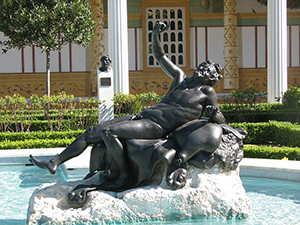Amethyst: formation, identification and legend.
A precious or semi-precious stone?
Historically, amethyst was classified as a precious stone, valued as highly as diamonds, sapphires, rubies and emeralds. However, after the discovery of vast deposits in Brazil and other locations around the world in the 19th century, amethyst became much more accessible and affordable. As a result, it was reclassified as a semi-precious stone due to its increased availability, although it remains highly prized for its beauty and distinct colour.
In jewellery and gemology, the terms 'precious' and 'semi-precious' are used less and less, as they can be misleading by suggesting an intrinsic value based solely on classification and not on the actual quality of the stone. Nevertheless, in common parlance, amethyst is often described as semi-precious to distinguish it from the four gems traditionally considered precious.
How is amethyst formed?
Amethyst is a variety of quartz.
The characteristic colour of amethyst, which varies from light to dark violet, is mainly due to the effect of natural irradiation and the presence of iron impurities in the quartz crystal. The irradiation in question generally comes from natural radioactive sources in the surrounding rocks.
This irradiation is a natural process that generally occurs during the formation of quartz in geological environments where the source rocks contain radioactive materials, such as uranium and thorium, which emit radiation over time. This can happen either during the initial growth of the crystals, or later if the crystals are exposed to new sources of radiation after their initial formation.
Source rocks" are the original rocks that contain or surround minerals such as amethyst. They can be thought of as the "soil" in which minerals "grow" and develop. These rocks provide the necessary ingredients for the minerals to form.
In the case of amethyst, these rocks are often rock types that come from the cooling of lava, such as basalt. These rocks may have small cavities or fissures where mineral-rich fluids accumulate and cool slowly. It is in these spaces that amethyst begins to form, crystallising little by little to become the beautiful violet crystals we see.
In short, source rocks are essential because they create the perfect environment for amethyst to form.
Amethyst, its history and legend.
Amethyst, with its beautiful violet hues, is not only a stone coveted for its beauty, it also has a history and a legend.
The most famous legend surrounding amethyst comes from Greek mythology and explains the origin of its unique colour and name. According to this legend, Dionysus, the god of wine, the vine and debauchery, was angry with a mortal and swore revenge on the next mortal who crossed his path. A young girl named Amethystos was this unfortunate victim. She was on her way to pay homage to the goddess Artemis, but suddenly found herself face to face with a drunken Dionysus.
To save her from the wrath of Dionysus, Artemis transformed the young girl into a shining, white statue of pure crystal. Realising the horror of his actions and filled with remorse, Dionysus poured wine over the statue, turning it a deep violet colour. In memory of this act and the young girl, the stone was named "amethyst", derived from the Greek word "amethystos", meaning "not drunk". The legend led to the belief that wearing an amethyst could protect against drunkenness and ensure clarity and sobriety.
Historically, amethyst was also prized by the nobility and the clergy. It adorned royal crowns, sceptres and ecclesiastical jewellery, symbolising purity and piety. Christian bishops, for example, often wore amethyst rings.


How to identify amethyst.
To identify a genuine amethyst, there are several characteristics to look out for. Firstly, the colour of amethyst varies from light to dark violet and can be transparent to translucent, often with visible internal inclusions called 'angel hair'. Secondly, its hardness, measured at 7 on the Mohs scale, enables amethyst to resist scratches from softer materials such as glass. What's more, amethyst remains cool to the touch, even when exposed to direct sunlight, which sets it apart from plastic or glass imitations. Finally, under UV light, amethyst may fluoresce red or blue, although this is not an absolute guarantee of its authenticity.
Conclusion
Amethyst is a stone that appeals to many people, from collectors to mineral enthusiasts, thanks to its rich history and beautiful violet colour. It has played an important role in legends and continues to be appreciated today for its beauty.
We invite you to discover some of the amethysts we offer on our site.
